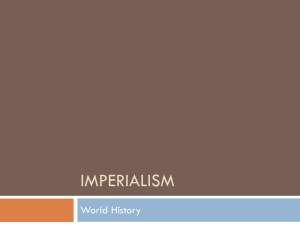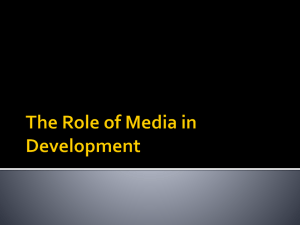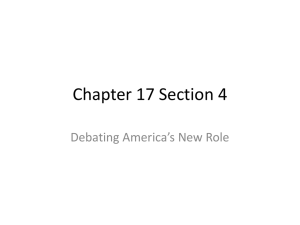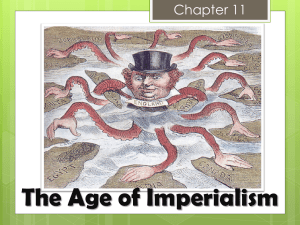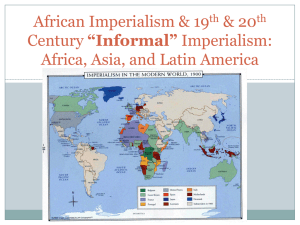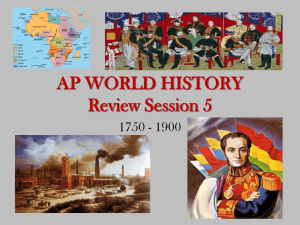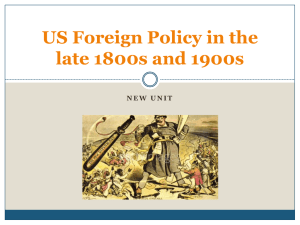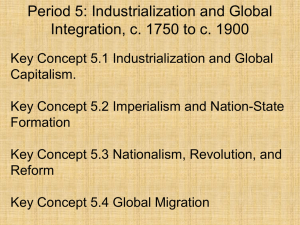JAT Chapter 20 - Dardanelle Public Schools
advertisement
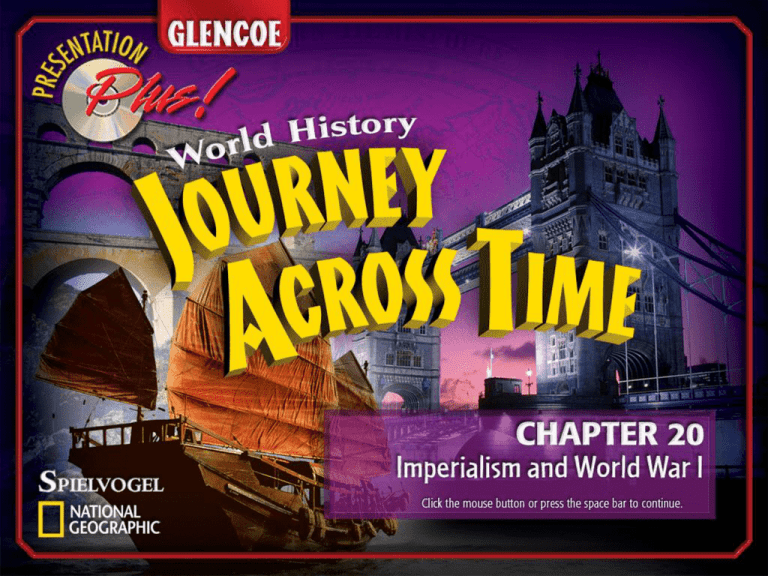
Imperialism and World War I Chapter Introduction Section 1 The New Imperialism Section 2 Nationalism in China and Japan Section 3 World War I Begins Section 4 World War I Changes the World Reading Review Chapter Assessment Click on a hyperlink to view the corresponding slides. Imperialism and World War I Chapter Objectives • Describe how Western powers built worldwide empires. • Analyze the effects of nationalism on China and Japan. • Summarize the events that led to World War I. • Explain how World War I changed the world. Imperialism and World War I The New Imperialism Get Ready to Read Section Overview This section explains why Western powers established empires in the1800s and 1900s. The New Imperialism Get Ready to Read (cont.) Focusing on the Main Ideas • European nations built empires to expand their economies and to spread their ideas. • Control of India passed from the East India Company to the British government. • European nations ruled almost all of Africa by 1914. The New Imperialism Get Ready to Read (cont.) Focusing on the Main Ideas (cont.) • The United States became an imperial nation after defeating Spain and taking control of the Philippines and Puerto Rico. Locating Places • Singapore (SIHNG·uh·POHR) • Cuba (KYOO·buh) The New Imperialism Get Ready to Read (cont.) Locating Places • Philippines (FIH·luh·PEENZ) • Panama (PA·nuh·MAH) Meeting People • Robert Clive • Leopold II • William McKinley The New Imperialism Get Ready to Read (cont.) Building Your Vocabulary • imperialism (ihm·PIHR·ee·uh·LIH·zuhm) • colony • protectorate (pruh·TEHK·tuh·ruht) • sphere of influence • sepoy (SEE·POY) The New Imperialism Get Ready to Read (cont.) Reading Strategy Organizing Information Use a chart like the one on page 762 of your textbook to show the colonies that each imperialist nation controlled. The New Imperialism The Rise of Imperialism • Imperialism is a type of relationship between countries in which one nation directly or indirectly controls the government or the economy of another nation. • Europeans wanted to acquire new lands and rule over foreign people, because they believed this added to their power. • Some imperial nations established a colony, which they ruled directly. (page 763) The New Imperialism The Rise of Imperialism (cont.) • Some set up a protectorate, in which local people had their own government, but the imperial government controlled the military and could tell local rulers what to do. • Other nations set up a sphere of influence, a region where only one imperial power had the right to invest or to trade. (page 763) The New Imperialism The Rise of Imperialism (cont.) • Europeans began taking over Southeast Asia’s mainland in the 1800s. • They grew crops and began using the area’s raw materials. • England set up a colony at the tip of the Malay Peninsula and called the colony Singapore. • The French followed the British to Southeast Asia, and the two countries competed for territory. (page 763) The New Imperialism The Rise of Imperialism (cont.) • In all of Southeast Asia, only Siam— which is today Thailand—kept its freedom. (page 763) The New Imperialism Why was Singapore important? Singapore was a port city that allowed passage to and from China, which was an important country in European trade. The New Imperialism Britain’s Empire in India • Members of the British East India Company built trading forts along India’s coasts in the 1600s. • The East India Company supported local Indian rulers who agreed to work with them. • Robert Clive was an East India Company official who, along with his army, pushed the French out of most of India. (pages 764–765) The New Imperialism Britain’s Empire in India (cont.) • The East India Company took over much of India and grew wealthy. • The East India Company brought many European ideas and customs to the Indian people. • Sepoys, Indian soldiers in the East India Company’s army, rebelled against the British officers. • The British government sent soldiers to India to end the rebellion. (pages 764–765) The New Imperialism Britain’s Empire in India (cont.) • After the rebellion, Britain took control of India from the East India Company. • A viceroy was sent to head the Raj, or the government of British India. • British rule both helped and hurt India. (pages 764–765) The New Imperialism How did the British hurt the local textile industry in India? The British exported large amounts of cheap cloth to India. People typically buy what is cheapest, and soon there were not enough buyers for more expensive locally made cloth. The Indian textile industry, which could not sell its products, was destroyed. The New Imperialism Europe Divides Africa • The first part of Africa to come under the control of Europe was North Africa. • The French took territories that today form the countries of Algeria and Tunisia. • They also divided Morocco with Spain. • Europeans began operating businesses in Egypt and built the Suez Canal, which linked the Mediterranean Sea and the Red Sea. (pages 766–768) The New Imperialism Europe Divides Africa (cont.) • The British took control of the canal, and the Egyptians rebelled. • After the rebellion, Britain made Egypt a protectorate. • In the 1800s, Britain declared the slave trade illegal, and many countries followed its lead. • Europeans took over areas of Africa’s Atlantic Coast to control trade in timber, hides, and palm oil. (pages 766–768) The New Imperialism Europe Divides Africa (cont.) • King Leopold II of Belgium decided to conquer Central Africa. • His plan was to make money selling rubber from plantations in the Congo. (pages 766–768) The New Imperialism Europe Divides Africa (cont.) • Other European countries followed Belgium, and by 1914, Europe controlled most of the African continent except Liberia and Ethiopia. • Dutch settlers, known as Boers, founded Cape Town in South Africa. • In the early 1800s, the British seized the Dutch territory. (pages 766–768) The New Imperialism Europe Divides Africa (cont.) • This forced the Boers to move inland to the Transvaal, where they met and fought with African people living there. • The Zulu were Africans who often fought the Boers but also fought the British. • The British eventually destroyed the Zulu Empire. (pages 766–768) The New Imperialism Europe Divides Africa (cont.) • The British decided to take the Transvaal from the Boers in 1899, and the Boer War erupted. • The Boers were defeated, and Britain brought together the Boer republics, the Cape Colony, and one other British colony to form the Union of South Africa. (pages 766–768) The New Imperialism How were African workers on King Leopold’s rubber plantations like slaves? Belgian soldiers forced Africans to collect rubber. Africans who resisted were shot. This was a form of forced labor. The New Imperialism The War of 1898 • In 1895, the Caribbean colony of Cuba rebelled against Spain. • In 1898, William McKinley, president of the United States, sent a U.S. battleship to Cuba to protect Americans there. • While anchored in Cuba, the ship exploded. • The United States blamed Spain for the explosion and declared war. (pages 769–770) The New Imperialism The War of 1898 (cont.) • The United States won, and Cuba became a republic under U.S. protection. • Puerto Rico, Guam, and the Philippines became American territories. • The Philippines rebelled against the United States, and the Americans crushed the rebellion. (pages 769–770) The New Imperialism The War of 1898 (cont.) • The United States gained control of Hawaii when American settlers there overthrew the Hawaiian queen. • To help move its navy quickly between the east and west coasts, the United States decided to build a canal across the Latin American country of Panama. • The United States helped Panama fight for its independence from Colombia. (pages 769–770) The New Imperialism The War of 1898 (cont.) • In exchange, Panama allowed the United States to build the canal. (pages 769–770) The New Imperialism How did Puerto Rico become a U.S. territory? After the United States defeated Spain in the War of 1898, the United States gained Puerto Rico from Spain. The New Imperialism Besides economics, what reasons did European countries have for building empires? to add to their country’s power and to spread Western ways The New Imperialism What was the Boer War and why was it fought? Dutch Boers fought to keep the British out of South Africa. The New Imperialism Explain Why were European nations interested in the countries of Southeast Asia? The British wanted Singapore for a trading stop. France took over Indochina to keep out the British. The New Imperialism Compare and Contrast How did British rule both help and hurt India? The British set up efficient government, schools, and railroads but destroyed India’s textile industry and caused starvation. The New Imperialism Analyze Describe the actions taken by the United States in Panama in the early 1900s. Why was the United States interested in Panama? The U.S. encouraged a rebellion in Panama. They wanted to build a canal to speed up trade. The New Imperialism Descriptive Writing Imagine you are a native of India in the late 1800s. Write a letter to a friend describing how you feel about British rule. Answers will vary. The New Imperialism Name a person, group, or place from the section for every letter in the word imperialism. Nationalism in China and Japan Get Ready to Read Section Overview This section describes Chinese nationalism and Japanese imperialism in the 1800s and 1900s. Nationalism in China and Japan Get Ready to Read (cont.) Focusing on the Main Ideas • The arrival of Europeans greatly changed Chinese society. • Sun Yat-sen introduced ideas that helped cause the collapse of the Qing dynasty. • After Americans visited Japan, the Japanese reorganized their society and economy and began building an empire. Nationalism in China and Japan Get Ready to Read (cont.) Locating Places • Hong Kong (HAHNG KAHNG) • Edo (eh·doh) • Port Arthur Meeting People • Sun Yat-sen (SUN YAHT·SEHN) • Yuan Shigai (YU·AHN SHIHR·KY) Nationalism in China and Japan Get Ready to Read (cont.) Meeting People • Oda Nobunaga (ohd·ah noh·bun·ah·gah) • Tokugawa leyasu (toh·kug·ah·wah ee·eh·yahs·u) • Matthew Perry • Mutsuhito (moot·suh·hee·toh) Nationalism in China and Japan Get Ready to Read (cont.) Building Your Vocabulary • extraterritoriality (EHK·struh·TEHR·uh·TOHR·ee·A·luh·tee) • daimyo (DY·mee·OH) Reading Strategy Summarizing Information Use a chart like the one on page 771 of your textbook to summarize the work of three Asian leaders. Nationalism in China and Japan China and the West • The Chinese followed their traditional way of life until the 1800s. • At that time, expanding European businesses wanted to increase their trade with China. • Although the British wanted Chinese goods, many Chinese did not want British goods. • This made the balance of trade unequal. (pages 772–774) Nationalism in China and Japan China and the West (cont.) • The British tried selling cotton, which the Chinese did not buy. • The British then began selling opium, an addictive drug, to the Chinese. • The demand for opium became high, and the British opium traders prospered. • When the Chinese emperor demanded the British stop selling opium, they refused. (pages 772–774) Nationalism in China and Japan China and the West (cont.) • The Opium War erupted in 1839 and lasted three years, until the emperor surrendered. (pages 772–774) Nationalism in China and Japan China and the West (cont.) • After being defeated, the Chinese gave five ports to British ships, limited taxes imposed on British goods, agreed to pay for the costs of war, and gave the British Hong Kong, an island that became one of the world’s busiest ports. • The British citizens in Hong Kong were subject to British laws, not Chinese laws. (pages 772–774) Nationalism in China and Japan China and the West (cont.) • This is called extraterritoriality. • In 1851, a religious leader named Hong Xiuquan (HAHNG SHYOO-CHWAHN) organized a rebellion to help peasants overthrow the emperor. • This rebellion became known as the Tai Ping Rebellion. • It lasted for 13 years. • Europeans helped the Chinese government defeat the rebels. (pages 772–774) Nationalism in China and Japan China and the West (cont.) • After the rebellion, Chinese leaders sold the right to trade, build, and conduct mining in their area to European nations. • The United States called for an Open Door policy, which allowed China to trade with all countries. • Many Chinese people began organizing secret groups to drive foreigners out of China. (pages 772–774) Nationalism in China and Japan China and the West (cont.) • Empress Tzu Hsi supported these groups, which the Europeans and Americans called Boxers. • In 1900, the Boxers attacked foreigners. • Europeans sent in troops to crush the Boxer Rebellion. (pages 772–774) Nationalism in China and Japan How did the Tai Ping Rebellion help Europe gain spheres of influence in China? Europe helped the Chinese defeat the rebels, and reform-minded Chinese believed Western technology could help keep rebellions at bay. The Chinese built railroads and shipyards and sold Europeans rights to trade, build, and mine in China. Nationalism in China and Japan The Revolution of 1911 • Middle-class Chinese grew angry when they learned that the legislative assemblies could not pass reform laws but only give advice to an emperor. • Peasants, artisans, and miners resented high taxes the government had imposed. (pages 774–775) Nationalism in China and Japan The Revolution of 1911 • Sun Yat-sen, a young doctor, founded a movement of revolutionaries that later became know as the Nationalist Party. • Sun developed a plan to change China. (pages 774–775) Nationalism in China and Japan The Revolution of 1911 (cont.) • In 1911, Sun’s followers overthrew the Qing dynasty, and they turned to the head of the Chinese army, Yuan Shigai, for support. • General Yuan agreed to serve as president of the new Chinese republic. • The Nationalist Party did not like Yuan’s method of rule. (pages 774–775) Nationalism in China and Japan The Revolution of 1911 (cont.) • They launched a revolt that ultimately failed. • General Yuan died in 1916, and the central government began to fall apart. • Warlords began to seize power and fight one another. (pages 774–775) Nationalism in China and Japan Why did the Nationalist Party disagree with Yuan’s rule? The Nationalist Party wanted to move toward democracy and selfrule. Yuan used the traditional way of military dictators and knew little of democracy. Nationalism in China and Japan The Rise of Imperial Japan • At the end of the 1400s, Japan’s shogun, or military ruler, no longer controlled the country. • Daimyo, or heads of noble families, ruled their own lands. • Three powerful leaders restored Japans central government: Oda Nobunaga, Toyotomi Hideyoshi, and Tokugawa Ieyasu. (pages 777–779) Nationalism in China and Japan The Rise of Imperial Japan (cont.) • Jesuit missionaries arrived in Japan and began converting thousands of Japanese to Christianity. • Hideyoshi expelled all missionaries after they destroyed Japanese shrines. • He also expelled European merchants. • Under Tokugawa rulers, samurai became managers on the lands of the daimyo, instead of warriors. (pages 777–779) Nationalism in China and Japan The Rise of Imperial Japan (cont.) • The class system also became rigid, excluding eta, or outcasts. • Matthew Perry, an American commodore, arrived in Japan in 1853 to invite Japan to trade with the United States. • Japan agreed and eventually agreed to trade with European nations. (pages 777–779) Nationalism in China and Japan The Rise of Imperial Japan (cont.) • Many Japanese disagreed with the trade policies, and a group of them attacked the shogun’s palace in Kyoto and took power. • Emperor Mutsuhito and his leaders, known as the Meiji, were determined to make Japan a great power. • They created a constitutional monarchy and set up a modern army and navy. • They also pushed Japan to industrialize. (pages 777–779) Nationalism in China and Japan The Rise of Imperial Japan (cont.) • The Japanese forced Korea to open to trade with Japan. • China controlled Korea and resented Japan’s presence there. • War broke out between Japan and China, and Japan captured the Manchurian city of Port Arthur. • After the war, China gave Japan Taiwan and gave Korea its independence. (pages 777–779) Nationalism in China and Japan The Rise of Imperial Japan (cont.) • Russia competed with Japan for trade with Korea. • Japan responded by attacking a Russian naval base in Port Arthur. • Russia tried to counterattack, but the Japanese defeated the Russians. • Russia agreed to give up Port Arthur. (pages 777–779) Nationalism in China and Japan How did the Meiji leaders strengthen Japan? The Meiji leaders created a constitutional monarchy that allowed people to vote for a legislature but kept power with the Meiji leaders. They built roads, improved schools, set up a modern army and navy, and required all men to serve in the military. They also pushed Japan to industrialize by helping to build new factories. Nationalism in China and Japan What were the causes of the Boxer Rebellion? Resentment of foreigners in China led a society called the Boxers to rebel. Nationalism in China and Japan Why did Admiral Perry sail to Japan? What was the result of his mission? to open relations between the U.S. and Japan; Japan agreed to trade with the West Nationalism in China and Japan Cause and Effect How did trade between Britain and China lead to the Opium War? To increase income, Britain sold opium to China. British ships fired on Chinese ports when Chinese leaders tried to stop the opium trade. Nationalism in China and Japan Compare and Contrast What was the Open Door Policy, and how was it different from European policies? Europeans established spheres of influence, whereas the Open Door Policy proposed that China trade with all countries. Nationalism in China and Japan Summarize Describe Japan’s rise to power in the late 1800s and early 1900s. Japan defeated China and then Russia in wars. Nationalism in China and Japan Persuasive Writing Write an editorial for a newspaper in China presenting your views on China’s treatment by the European powers. Answers will vary. Nationalism in China and Japan Complete the following sentence: The best thing to happen in East Asia during the 1800s and 1900s was… World War I Begins Get Ready to Read Section Overview This section explains the causes of World War I and describes the beginning stages of the war. World War I Begins Get Ready to Read (cont.) Focusing on the Main Ideas • Alliances, militarism, and nationalism led to a crisis in Europe. • The assassination of Archduke Franz Ferdinand sparked World War I. • Americans supported the Allies because of pro-British feelings and business links. World War I Begins Get Ready to Read (cont.) Locating Places • Balkans (BAWL·kuhnz) • Serbia (SUHR·bee·uh) Meeting People • Franz Ferdinand (FRANZ FUHR·duhn·AND) • Woodrow Wilson World War I Begins Get Ready to Read (cont.) Building Your Vocabulary • militarism (MIH·luh·tuh·RIH·zuhm) • conscription (kuhn·SKRIHP·shuhn) • entente (ahn·TAHNT) • mobilization (MOH·buh·luh·ZAY·shuhn) • rationing • propaganda (PRAH·puh·GAN·duh) • blockade World War I Begins Get Ready to Read (cont.) Reading Strategy Contrasting Use a Venn diagram like the one on page 780 of your textbook to show the major countries that made up the Allies and the Central Powers. World War I Begins The Causes of World War I • European nations had expanded so much that further expansion brought them into conflict with each other. • Nations strengthened their armies as they competed for colonies. • This led to militarism, or a fascination with war and the military. (pages 781–783) World War I Begins The Causes of World War I (cont.) • Germany, France, and Russia filled their armies with soldiers by using conscription, which requires citizens to serve in the military for a certain period of time. • Britain had the world’s most powerful navy. • Germany, Austria-Hungary, and Italy formed the Triple Alliance. (pages 781–783) World War I Begins The Causes of World War I (cont.) • Britain, France, and Russia formed the Triple Entente. • An entente is an understanding among nations. • In the early 1900s, groups in the Balkans, an area in southeastern Europe, demanded independence from the Ottoman and Austro-Hungarian empires. (pages 781–783) World War I Begins The Causes of World War I (cont.) • The South Slavs were nationalists, and included several groups, such as the Serbs, who created a state called Serbia. • The Serbs believed their mission was to unite the South Slavs. • The Russians backed the Serbs. (pages 781–783) World War I Begins The Causes of World War I (cont.) • To keep the South Slavs in their empire from joining the Serbs, Austria-Hungary took over Bosnia, which angered the Serbs. • The Russians and the Serbs prepared to fight Austria-Hungary, and Germany sided with Austria-Hungary. • The Balkan League declared war on the Ottoman empire in 1912. (pages 781–783) World War I Begins The Causes of World War I (cont.) • The Treaty of Bucharest ended the fighting. (pages 781–783) World War I Begins What happened to the Balkan League? The Balkan League fell apart after the countries in the league began fighting with each other. Greeks and Serbs demanded land from Bulgaria, so Bulgaria attacked Greece and Serbia. World War I Begins The War Begins • Archduke Franz Ferdinand, heir to the throne of Austria-Hungary, was shot dead in Bosnia in June 1914. • The assassin, Gavrilo Princip, was a member of the Black Hand, a secret nationalist group that wanted the Bosnian Serbs to be ruled by Serbia, not Austria-Hungary. • Austria-Hungary declared war on Serbia. (pages 784–786) World War I Begins The War Begins (cont.) • Serbia’s ally, Russia, began mobilization, or assembling and moving troops for war. • Germany showed support for AustriaHungary by declaring war on Russia. • France entered the war and sided with Russia. • Germany invaded Belgium, and Britain, Belgium’s ally, declared war on Germany. (pages 784–786) World War I Begins The War Begins (cont.) • France, Russia, and Britain, and later Italy, were known as the Allies. • Germany, Austria-Hungary, Bulgaria, and the Ottoman empire were known as the Central Powers. • The Western Front was a battle zone between France and Germany, where much of the fighting took place. (pages 784–786) World War I Begins The War Begins (cont.) • Troops conducted trench warfare, a type of fighting in which troops dug themselves into the ground in trenches surrounded with barbed wire. (pages 784–786) World War I Begins The War Begins (cont.) • New types of weapons were used in World War I, including machine guns, poison gases, submarines, and airplanes. • The war effort involved everyone. • Supplies were diverted to soldiers, which meant that resources were not as available to civilians. (pages 784–786) World War I Begins The War Begins (cont.) • Rationing limited the amount and type of supplies available to civilians. • Governments also used propaganda, or biased information, to shape what people thought. (pages 784–786) World War I Begins How was World War I different from previous wars? Both sides had new, more powerful weapons. Citizens’ lives were directly affected by the war. The governments made use of propaganda to control public opinion. World War I Begins America Enters the War • Woodrow Wilson, the U.S. president at the beginning of World War I, declared the United States impartial. • Many of Wilson’s advisors backed Britain. • U.S. loans, food, aid, and supplies were sent to the Allies. • The British imposed a blockade on Germany, using warships to stop goods from leaving or entering German ports. (pages 786–788) World War I Begins America Enters the War • To fight back, Germans began using U-boats, or submarines, to sink any ship sailing around Britain. • The British passenger liner Lusitania was sunk by German U-boats, killing 128 Americans. • In 1917, a cable from a German official was intercepted by Britain. (pages 786–788) World War I Begins America Enters the War • The cable proposed that if war were to break out with America, Mexico would join with Germany to fight against the United States. • In return, Germany would give Texas, New Mexico, and Arizona to Mexico. • The British gave the cable to American newspapers, and angered Americans demanded war with Germany. (pages 786–788) World War I Begins America Enters the War • Germany sank six American merchant ships between February 3 and March 21 of 1917. • On April 6, 1917, President Wilson asked Congress to declare war on Germany. (pages 786–788) World War I Begins How did German U-boats contribute to the United States entering the war? The U-boats sank the Lusitania, killing 128 Americans. Americans were outraged, and the Germans promised to give a warning before sinking ships. After interception of the Zimmermann cable, the Germans began sinking ships without warning and sank six American merchant ships. World War I Begins What happened in Sarajevo in 1914, and why was it important? The assassination of Archduke Ferdinand led to World War I. World War I Begins Name three things that led to World War I. Possible answers: nationalism, militarism, desire to build larger empires, tangled alliances, and the assassination of Archduke Ferdinand World War I Begins Explain What is militarism, and what problems did it cause in Europe? a nation’s focus on war and weapons; led to arms races, larger armies, and insecurity in Europe World War I Begins Cause and Effect Why did the soldiers decide to use trench warfare? Many soldiers were killed; new kinds of weapons were invented. World War I Begins Analyze Why was World War I a “total war”? Governments mobilized people, rationed food, and took over factories and transportation. World War I Begins Expository Writing Write a headline and a brief article about the U.S. entry into World War I. Discuss the reasons why the United States finally entered the war. Answers will vary. World War I Begins Perform a roll call vote among your classmates on whether the U.S. should have entered WW I. World War I Changes the World Get Ready to Read Section Overview This section sums up the last years of the war, the results of the peace negotiations, and the events of the Russian Revolution. World War I Changes the World Get Ready to Read (cont.) Focusing on the Main Ideas • With American help, the Allies stopped the German advance. • The Bolsheviks rose to power as a result of the czar’s poor leadership. Locating Places • Argonne Forest • Versailles (vuhr·SY) World War I Changes the World Get Ready to Read (cont.) Meeting People • David Lloyd George • Georges Clemenceau (zhawrzh KLEH·muhn·SOH) • Vittorio Orlando (veet·TAWR·yoh awr·LAN·doh) • Ataturk (AT·uh·TUHRK) • Vladimir Lenin (VLAD·uh·MIHR LEH·nuhn) World War I Changes the World Get Ready to Read (cont.) Building Your Vocabulary • Armistice (AHR·muh·stuhs) • reparation (REH·puh·RAY·shuhn) • mandate (MAN·dayt) • duma (DOO·muh) • soviet (SOH·vee·EHT) World War I Changes the World Get Ready to Read (cont.) Reading Strategy Organizing Information Use a diagram like the one on page 789 of your textbook to show the new territories created from the Ottoman empire. World War I Changes the World The War Ends • Russia pulled out of World War I in November 1917. • German troops were sent from the Eastern Front to the west. • The Americans launched an attack on the Germans in the Battle of the Argonne Forest. • The Ottoman Turks surrendered, and the German emperor, afraid of mutiny in the navy and a revolt in Berlin, stepped down. (pages 790–792) World War I Changes the World The War Ends (cont.) • On November 11, 1918, Germany signed an armistice, or cease-fire, to end the war. • In 1919, peace talks began in Versailles outside Paris. • U.S. president Woodrow Wilson, British prime minister David Lloyd George, French premier Georges Clemenceau, and Italian prime minister Vittorio Orlando were lead figures at the talks. (pages 790–792) World War I Changes the World The War Ends (cont.) • The Treaty of Versailles stripped Germany of most of its army. • It required Germany to pay reparations, or war damages, to the Allies. • It also created the League of Nations, which would help keep the peace. • The U.S. Senate rejected the League of Nations, so it was formed without the United States. (pages 790–792) World War I Changes the World The War Ends (cont.) • After the war, the Austro-Hungarian Empire disappeared, and its land became individual nation-states. • The treaty could not give each ethnic group its own country, so almost every new country combined a dominant group and smaller groups. • The Allies broke up the Ottoman empire, leaving only the area of present-day Turkey. (pages 790–792) World War I Changes the World The War Ends (cont.) • Turkey became a republic in 1923 after driving out Greek invaders. • Mustafa Kemal, also known as Atatürk, became president of Turkey. • He introduced many social and political changes. • The Allies divided up Arab regions of the Ottoman empire, creating new territories called mandates. (pages 790–792) World War I Changes the World The War Ends (cont.) • The League of Nations governed each territory, but allowed a member nation to run it. • Ibn Saud created the kingdom of Saudi Arabia in 1932. • American businesses struck oil at Dhahran, and the kingdom became wealthy. (pages 790–792) World War I Changes the World The War Ends (cont.) • Jewish nationalists known as Zionists had begun settling in the ancient city of Jerusalem in Palestine, a mandate run by Britain. • The Balfour Declaration promised Jews a nation in Palestine, which angered Arabs living there. (pages 790–792) World War I Changes the World How did mandates affect Muslims? Mandates were run by a member of the League of Nations, so mandated territories in the Middle East were run by outsiders, which angered the Arabs. World War I Changes the World The Russian Revolution • In the early 1900s, most Russians were unhappy with their government. • In 1905 an uprising began, and thousands of workers demanded changes from the czar. • Soldiers fired on the workers and killed hundreds. • In response, the workers went on strike. (pages 793–796) World War I Changes the World The Russian Revolution (cont.) • The czar agreed to meet some of the workers’ demands and created a duma, or national assembly. • Russia suffered great losses in World War I , and in 1917 the people rose up against the czar. (pages 793–796) World War I Changes the World The Russian Revolution (cont.) • The soldiers joined the people, and the czar gave up his rule. • Members of the duma created a temporary government, but it did not carry out the reforms the people wanted. • The people believed the temporary government was too middle class, so they formed soviets, or committees, to represent their interests. (pages 793–796) World War I Changes the World The Russian Revolution (cont.) • Many members of the soviets were socialists. • The most radical of these groups was the Bolsheviks, led by Vladimir Lenin. (pages 793–796) World War I Changes the World The Russian Revolution (cont.) • They believed they could use force to bring about their ideal classless society. • In November 1917, the Bolsheviks seized power, and Lenin became the head of the new government. • Several groups opposed Lenin and rebelled against the Bolsheviks, now known as Communists, or Reds. (pages 793–796) World War I Changes the World The Russian Revolution (cont.) • Leon Trotsky formed the Communist army, called the Red Army. • The enemies of the Communists were called Whites. • The Reds and Whites fought for three years until the Communists won in 1921. (pages 793–796) World War I Changes the World What were some of the political beliefs of the Bolsheviks? The Bolsheviks opposed capitalism. They wanted a socialist government that would build a society in which all people could share equally in the wealth. World War I Changes the World What were the Fourteen Points and why were they important? The Fourteen Points were Wilson’s plan for peace. They were important to form a League of Nations. World War I Changes the World What changes did Atatürk make after becoming president of Turkey? He erased Arabic features from the language, made Turks adopt last names, and rid government of Islamic influences. World War I Changes the World Analyze Were the attempts to create countries along ethnic lines following World War I successful? Why or why not? The mix of peoples and Allied interests made countries of one ethnicity impossible. World War I Changes the World Sequencing Information Describe the major events leading to the fall of the Russian czar. Answers may include: Rigid rule failed to solve new problems; Defeat in war with Japan hurt Russian economy; Violent reaction to workers’ uprising and closing of duma; Severe casualties in World War I; Workers desperate for food and peace World War I Changes the World Analyze How were Lenin and the Bolsheviks able to come to power in Russia? Lenin and the Bolsheviks promised the people they would end the war and start reforms. They seized power from the provisional government. World War I Changes the World Writing Questions Imagine you are a reporter in the era of World War I. Write a series of four or five questions that you would like to ask the leaders of Europe. Include possible answers to your questions. Questions should reflect an understanding of the section. World War I Changes the World Name an interesting historical figure from the section and explain why that person is significant. Imperialism and World War I Section 1: The New Imperialism Focusing on the Main Ideas • European nations built empires to help their economies and to spread their ideas. • Control of India passed from the East India Company to the British government. • European nations ruled almost all of Africa in 1914. Imperialism and World War I Section 1: The New Imperialism Focusing on the Main Ideas • The United States became an imperial nation after defeating Spain and taking control of the Philippines and Puerto Rico. Imperialism and World War I Section 2: Nationalism in China and Japan Focusing on the Main Ideas • The arrival of Europeans greatly changed Chinese society. • Sun Yat-sen introduced ideas that helped cause the collapse of the Qing dynasty. • After Americans visited Japan, the Japanese reorganized their society and economy and began building an empire. Imperialism and World War I Section 3: World War I Begins Focusing on the Main Ideas • Alliances, militarism, and nationalism led to a crisis in Europe. • The assassination of Archduke Franz Ferdinand sparked World War I. • Americans supported the Allies because of pro-British feelings and business links. Imperialism and World War I Section 4: World War I Changes the World Focusing on the Main Ideas • With American help, the Allies stopped the German advance. • The Bolsheviks rose to power as a result of the czar’s poor leadership. Imperialism and World War I Review Vocabulary Define Match the vocabulary word that completes each sentence. G 1. Head of noble families __ in Japanese society were called ___. A 2. Russian workers __ formed ___ to voice their concerns. __ D 3. The government of a(n) ___ is guided by a foreign power. C 4. A cease-fire is also __ called a(n) ___. A. B. C. D. E. F. G. H. soviets conscription armistice protectorate reparations colony daimyo entente Imperialism and World War I Review Vocabulary Define Match the vocabulary word that completes each sentence. B 5. ___ requires citizens to __ join the military. F 6. A(n) ___ was directly __ ruled by an imperial nation. E 7. Germany paid war __ damages, or ___, to the Allies. __ H 8. An understanding among nations is called a(n) ___. A. B. C. D. E. F. G. H. soviets conscription armistice protectorate reparations colony daimyo entente Imperialism and World War I Review Main Ideas Section 1 The New Imperialism Why did European nations establish empires? The nations wanted to control raw materials and markets, to add to their county’s power, and to help Asians and Africans by imposing Western ways. Imperialism and World War I Review Main Ideas Section 1 The New Imperialism Why were European nations interested in Africa? to spread Christianity, to improve trade and control resources Imperialism and World War I Review Main Ideas Section 2 Nationalism in China and Japan How did the arrival of the Europeans change Chinese society? Europeans and other Westerners broke China up into spheres of influence for trade. The government began reforms to modernize China. Imperialism and World War I Review Main Ideas Section 2 Nationalism in China and Japan How did Sun Yat-sen’s ideas lead to the collapse of the Qing dynasty? Sun wanted to form a strong government to get out from under foreign control. His followers staged an uprising, causing the Qing dynasty to fall. Imperialism and World War I Review Main Ideas Section 3 World War I Begins Explain the causes of World War I. alliances, militarism, and trouble in the Balkans Imperialism and World War I Review Main Ideas Section 3 World War I Begins Why did Americans support the Allies? pro-British feelings and business links Imperialism and World War I Review Main Ideas Section 4 World War I Changes the World What resulted from the German advance on the Allies? The Allies stopped the advance with American help. Imperialism and World War I Review Main Ideas Section 4 World War I Changes the World Why were the Bolsheviks able to rise to power in Russia? The Bolsheviks rose to power because they promised to get out of World War I and initiate domestic reforms in Russia. Imperialism and World War I Cause and Effect What caused the Boer War? The Boer War began when the British started prospecting for gold and diamonds in the Boers’ territory. Imperialism and World War I Analyze Instead of importing opium to China, what else might the British have done to restore the balance of trade? Answers will vary. Imperialism and World War I Explain How did the assassination of Ferdinand lead to war? Austria-Hungary blamed Serbia for the assassination and declared war on Serbia. Russia mobilized to defend Serbia, and Germany declared war on Russia. Germany also made plans to invade France, so Great Britain declared war on Germany. Imperialism and World War I Analyze Do you think the Treaty of Versailles asked too much of Germany? Why or why not? Answers will vary. Explore online information about the topics introduced in this chapter. Click on the Connect button to launch your browser and go to the Journey Across Time Web site. Click on Chapter 20-Chapter Overviews to preview information about this chapter. When you finish exploring, exit the browser program to return to this presentation. If you experience difficulty connecting to the Web site, manually launch your Web browser and go to http://www.jat.glencoe.com Maps Imperialism in Southern Asia c. 1900 Imperialism in Africa c. 1914 Spheres of Influence in China 1911 The Japanese Empire Europe Before World War I 1914 World War I 1914–1918 The Western Front Europe After World War I Middle East 1919–1935 Click on a hyperlink to view the corresponding slides. Click the map to view an interactive version. Click the map to view an interactive version. The New Imperialism Joseph Jenkins Roberts was the first president of Liberia, a country in Africa founded by freed slaves from the United States. Roberts was born a free man and grew up in Virginia. He is known as the father of Liberia. Nationalism in China and Japan Hong Kong remained a British colony until 1997. As a result, the culture of Hong Kong had many British influences. For example, schools in Hong Kong follow the British system. Hong Kong tea culture is different from the traditional Chinese tea culture. World War I Begins Alfred Gwynne Vanderbilt was a wealthy American and the father of William Henry Vanderbilt III, who became governor of Rhode Island. He died on board the Lusitania, after giving his life jacket to another passenger. World War I Changes the World The Russian czar Nicholas and his immediate family were canonized and made saints by the Russian Orthodox Church in 2000. Reading Social Studies Learn It! What’s Important? As you study history, it may seem impossible to keep all the facts in your head. Once you understand that the author does not expect you to remember every word of the text, you can begin to focus on what is truly important or prioritize. Prioritize means “to list in order of importance.” Prioritizing will help you read more critically and do better on tests. Read the sentences on the following slide. Reading Social Studies The words in blue show the ideas that the author intended to be most important. World War I, also called the Great War, was different from any earlier war. Both sides developed new, more powerful weapons to help them break through enemy lines. Machine guns fired bullets one after the other at a rapid speed. Huge artillery guns fired shells more than 75 miles (120 km). Poison gases were used for the first time, and tanks and flamethrowers were introduced. Reading Social Studies World War I, also called the Great War, was different from any earlier war. Both sides developed new, more powerful weapons to help them break through enemy lines. Machine guns fired bullets one after the other at a rapid speed. Huge artillery guns fired shells more than 75 miles (120 km). Poison gases were used for the first time, and tanks and flamethrowers were introduced. The other sentences act as supporting details. Reading Social Studies World War I, also called the Great War, was different from any earlier war. Both sides developed new, more powerful weapons to help them break through enemy lines. Machine guns fired bullets one after the other at a rapid speed. Huge artillery guns fired shells more than 75 miles (120 km). Poison gases were used for the first time, and tanks and flamethrowers were introduced. Reading Social Studies Practice It! Read this paragraph from Section 4, page 791. Discuss the questions that follow with a learning partner to practice prioritizing. In January 1919, peace talks began at Versailles (vuhr·SY) outside Paris. The principal figures at the talks were U.S. president Woodrow Wilson, British prime minister David Lloyd George, French premier Georges Clemenceau, and Italian prime minister Vittorio Orlando. Reading Social Studies 1. Is it important to remember the date of the peace talks? 2. Is it important to remember where the peace talks occurred? 3. Is it important to remember the principal figures at the talks? 4. Is it important to read further to find out more about the peace talks? Imperialism and World War I Introduction The New Imperialism Nationalism in China and Japan World War I Begins World War I Changes the World Standard Treaty Ten Days That Shook the World Sun Yat-Sen 1866–1925 Vladimir Lenin 1870–1924 Chapter 20 Daily Focus Skills Transparency 20–1 Chapter 20 Daily Focus Skills Transparency 20–2 Opium imports more than doubled in China from 1832 to 1839. Chapter 20 Daily Focus Skills Transparency 20–3 Chapter 20 Daily Focus Skills Transparency 20–4 To use this Presentation Plus! product: Click the Forward button to go to the next slide. Click the Previous button to return to the previous slide. Click the Menu button to return to the Chapter Menu. Click the Return button in a feature to return to the main presentation. Click the Exit button or press the Escape key [Esc] to end the chapter slide show. Click the Help button to access this screen. Links to Presentation Plus! features such as the Reference Atlas, Daily Focus Transparencies, and others are located on the left side of the relevant slides. End of Custom Shows This slide intentionally blank

